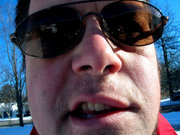Re: Jane Doe
To whom it may concern:
The patient was seen in my San Juan Capistrano, Calif., office for an initial evaluation. She presented with moderate left upper-arm and hand paraesthesias, accompanied by left-sided facial paraesthesias. She reported onset of symptoms approximately one week ago, which were worsening. She also reported the onset of a headache in the right temporal region. She has gained no relief with over-the-counter drugs, and her primary goal is pain relief. Past medical history was significant for 1995 intrabody cervical fusion, discectomy at spinal levels C5-7.
Source of Facts
1. history as provided by the patient; and
2. physical examination.
The patient complained of left-sided neck pain and primarily right-sided headaches. The reason for today's visit was the facial involvement and, most importantly to this patient, left upper-limb involvement. The pain level was rated 7 on a scale of 1-10, with 10 being severe pain with moderate interference in activities of daily living. The patient was provided a detailed examination, and on my medical record review, the findings confirmed suspected left Bell's palsy; left cervical C6 radiculopathy; and left C7 radiculopathy, with probable spinal cord impingement. I suspect the intrabody fusion is stable. She reported severe sleep disturbance and left upper-limb disturbance because of the pain. The right-sided headaches seem unrelated, yet warrant investigation to differentiate a neurological vs. biomechanical component. There were no clinical objective findings for a cerebral vascular injury to explain the unilateral headache, but strong clinical suspicion exists that it is related to the left intrabody fusion, by virtue of ropy bands and palpable myospasm of the right cervical region.
She was intolerant of forward head flexion, and pain was worsened by overhead or upper-arm use to severe "pinching effect." The pain extended below the shoulder, and she grabbed her left middle deltoid and left dorsal hand muscle and stated; "It hurts [and is] numb deep under this muscle."
Physical Examination
While observed in the reception area, the patient avoided neck-turning and presented with a facial grimace. Normotensive findings: 110/64 left; 110/66 right; pulse at 76 BPM; respirations 20/min. Warm, dry and pink, capillary refill less than two seconds. Osseous palpation of the right cervical vertebral levels C2-3 positive; left facet joints yielded limited P-A motion and painful muscle splinting.
Cervical spine active range of motion was restricted and somewhat slow; extension was the worst and recorded at 15 degrees with crepitus. Valsalva and Dejerine's signs were absent for discogenic origin.
Seated deep tendon reflexes of the upper extremities demonstrated +1 asymmetrically, using the Wexler Grading Scale C6 and C7. Mensuation revealed 10 inches forearm bilateral, without atrophy noted. No pronator drift was recorded.
Neurological testing of the motor portion of the upper extremities that receive innervation from the cervical region, in testing sensory discrimination to pain sensation, was abnormal for left dermatome region C6, C7. Sensory testing of the 7^sup th^ cranial nerve (facial) left exhibited a heightened response. No obvious mouth paralysis was noted; elevation of brow and wrinkling of forehead were intact. Tight closing of the eye was somewhat weaker on the left with thumb lift. No facial edema or facial tremors were noted.
Diagnosis
* probable facial nerve involvement, possible Bell's palsy left;
* possible upper motor lesion;
* postoperative intrabody fusion failure (suspect instability of cervical spine); and
* comorbidity of cervical posterior joint syndrome and spondylosis.
Treatment Plan
1. Monitor neurological status to differentiate UMN vs. LMN;
2. STAT MRI cervical spine;
3. STAT referral for pain management to MD in Newport Beach; and
4. STAT referral to neurosurgeon for clinical correlation of findings.
Thank you for consenting to see this patient. I look forward to your findings.
Nancy Molina, DC
San Juan Capistrano, California
Nancy Molina, DC. Dr. Molina's articles, a "Talk Back" forum and a brief biography of the author are available online at www.chiroweb.com/columnist/molina.
A printable version of Dr. Molina's article is available online at www.chiroweb.com/columnist/molina. You may also leave a comment or ask a question at her "Talk Back" forum at the same location.
Copyright Dynamic Chiropractic May 5, 2003
Provided by ProQuest Information and Learning Company. All rights Reserved



